|
The Versey Crew.
Flt Lt B G Versey Pilot
Sgt L W Cass Nav
F.O. A Clarke Air Bomber
Sgt A R Miller Flt Eng
Sgt L Brittain W.Op
Sgt D Jackson MU Gunner
Sgt J A G Cox Rear Gunner

149 (East India ) Squadron Aircrew in 1944 at Methwold in front of a Lancaster.

A look at the ‘Lancaster’ interior.
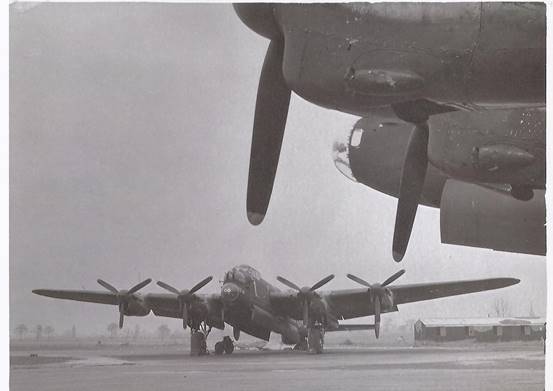
OJ-A at Methwold
Pilots.
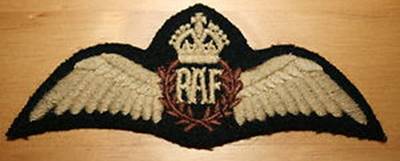
These crew members were not just the flyers of the aircraft, they were its 'skipper'. This meant that they were required to demonstrate not just the ability to fly, but the qualities required to be the 'leaders' of their crew and have at least a modicum of knowledge of all the crew’s positions tasks and functions. So a pilot learned about navigation, bombing, gunnery, radio procedures and the technical skills required to manage the aircraft systems. They were not required to use all these skills in the air, but needed them to underline the other crew's functions.
To this end, the training was a multi-faceted affair, with flying at its heart. After the initial assessment the training route varied. Some pilots were trained in the UK, but many were passed to the ‘Arnold’ scheme or the BCATP (British Commonwealth Air Training Plan) scheme.
The Arnold Scheme was brought into being with the aid of General 'Hap' Arnold in the USA. In it, a number of trainee pilots were sent by ship to Canada and then by train to training units in the south of America. The weather conditions were very conducive to amassing a reasonable number of training hours without having to rely on the British weather. It was not an easy option, however, with high dropout rates and more than a few accidents keeping the numbers fined down from the initial intake.
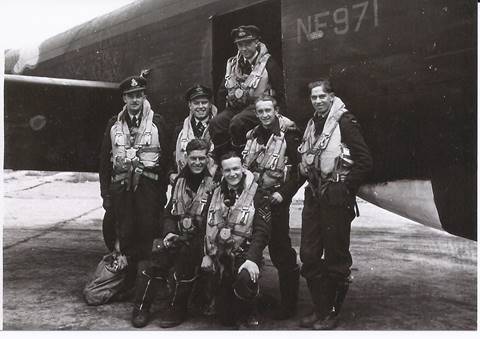
Navigators - The observer, at the start of world war two, was the navigator and bomb aimer of the crew. As systems developed and navigational aids were increased the actual navigation of the aircraft rose in importance, as did the function of bomb aiming. In larger aircraft these positions were mutually incompatible, as the navigator needed to spend his time plotting and checking his course. Navigators, and Bomb Aimers eventually replaced the Observer aircrew category, as the workload required of them increased. Navigators were dedicated to the accurate navigation of the aircraft and the use of the various navigational aids fitted.
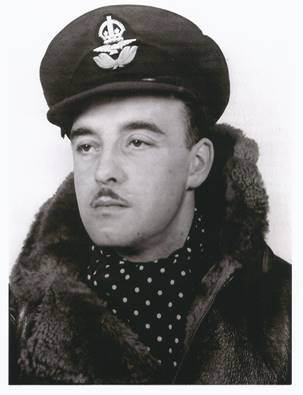
An evocative pose from a young Lester Cass, Versey's Navigator..
Date unknown, but post March 1945.
Lester Cass’ Navigator Training.
Lester came late to the war, joining in mid 1943 and starting his flying training in November. He qualified as an Air Navigator in February 1944.
No 41 Air School. Collondale, East London, South Africa. (Formerly No 1 Air Observer’s school S.A.A.F.) is where he started his training in November 1943, flying in Avro Anson aircraft. He qualified as a Navigator in February 1944.
After making the trip from South Africa to the UK he was posted to No 6 (O) AFU (Advanced Flying Unit) in May ’44 and continued training on Anson aircraft until mid June of that year. His next posting was to No 20 OTU (Operational Training Unit) at RAF Lossiemouth in Moray, Scotland. This was in July 1944. It was here that he first crewed up with Flt Lt Versey, who would be his regular pilot for the rest of the war.
The aircraft they were flying in was the Vickers Wellington and they continued their training until the 18th of July ’44 at Lossiemouth.
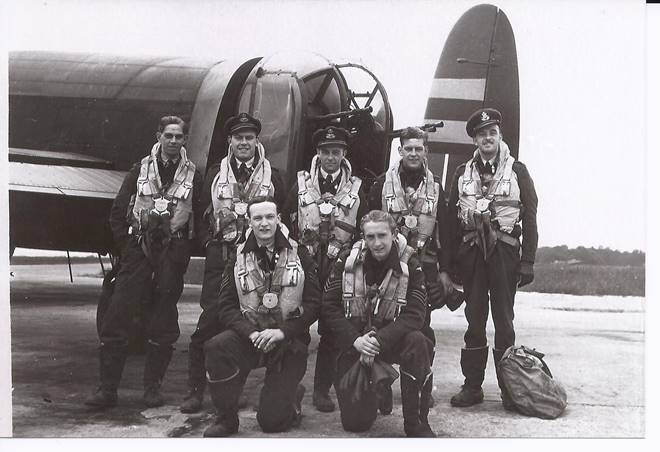
The ‘Count’ at Methwold with Versey's crew.
Flight Engineers –
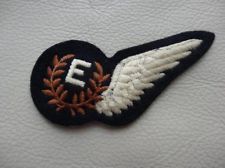
These personnel were, initially at least, drawn from the ranks of the technical personnel on squadrons. They had already acquired the skills and knowledge to work with some of the aircraft systems and required less training to fit them for their task as the aircraft's 'technical expert' on board. As the war progressed, so the recruiting of Flight Engineers was expanded to include direct entrants with limited or no technical knowledge.
Sgt Albert Miller’s Flight Engineer training.
( Flight Eng training information adapted from the website http://rafww2butler.wordpress.com/ with permission and grateful thanks)
In early 1944, Bert received instructions to attend a two-day assessment at an Aviation Candidates Selection Board (ACSB).
As directed, he packed a small suitcase, his civilian respirator and the requisite paperwork and travelled to No 2 Recruit Centre at RAF Cardington in Bedfordshire.
Over the next couple of days he undertook a series of medical examinations/tests which assessed his aptitude for the six aircrew categories, namely pilot, navigator, bomb-aimer, air-gunner, wireless operator and flight engineer.
The standard suite of tests included:
- essay writing
- elementary maths
- general intelligence
- coordination
- fitness
On the second, he was interviewed by an Aviation Candidate Selection Board (ACSB) and at the end of the process, the board recommended him “for training as flight mechanic, potential flight engineer”.
Albert was sent before the Attestation Officer where, after formally signing his Notice Paper (Form 2168), he was asked to swear allegiance to his King and Country:

Having completed his assessment, ‘Bert was enlisted in the RAF “for the duration of the present emergency” (d.p.e.) and placed “on reserve” (which was standard RAF procedure at the time); once again, he returned home to
He received a letter from the Secretary of State for Air, which welcomed him into the RAF and advised him that he would be called up as soon as he was required; he now had to patiently await that call up.
Albert was duly called up and went to his Initial Training Wing (No 3 ITW) at Torquay in Devon.
He was posted into No 2 Squadron, No 21 Initial Training Wing (ITW), which specialised in basic service training of flight engineers. Other ITW’s specialised in training the other aircrew categories, namely Pilot, Navigator, Bomber (PNB Scheme) and Wireless Operator, Air Gunner (WOP / AG).
Bert was probably allocated the usual “bed space” in a room in one of the hotels that had been allocated to 3 ITW (believed to be the Park Hall, Regina, Dorchester and Devonshire Hotels and smaller hotels in Beacon Terrace).
As trainee aircrew, he would have been provided with sheets and pillow cases for his bed, along with the standard “mattress biscuits”, blankets and pillow.
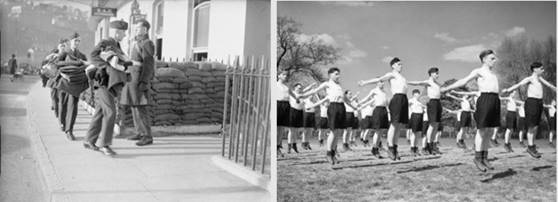
Billets and Physical Training [Photographs © IMW CH1790 / CH10992]
The approach used during the ITW training programme was explained in the pamphlet “YOU are going to be a FLIGHT ENGINEER“
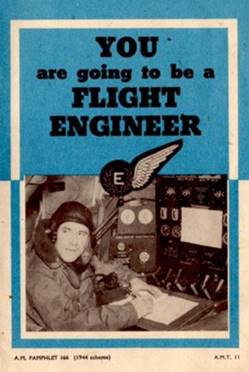
Bert would have been issued with his War Service (“Battledress”) uniform, which consisted of tunic and trousers. This could be worn in place of the “Best Blues” jacket and trousers whilst “working on station” (“Best Blues” had to be worn on parade, at formal occasions and whenever the trainee was “off station”).
The “Initial Training Wing Syllabus” and the supporting “Aircrew Lecture Notes” show that recruits were taught:
- anti-gas
- aircraft recognition
- armament
- drill and physical training
- engines
- hygiene and sanitation
- law and discipline, administration and organisation
- mathematics
- meteorology
- navigation
- principles of flight
- signals
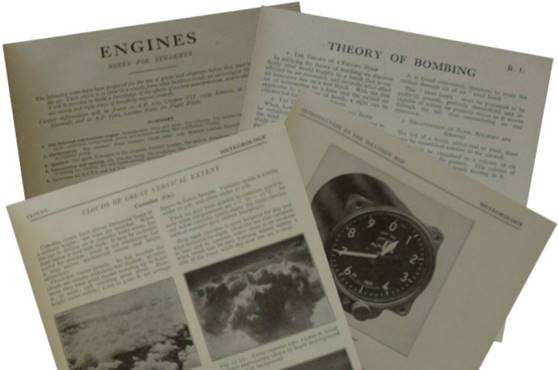
An extract from ”Aircrew Lecture Notes”
Flying Clothing, along with a second kitbag, was issued later in the course for use in some of the training exercises. It consisted of:
- helmet, with oxygen and communication mask
- goggles
- flying suit (one piece or separate jacket and trousers)
- leather gauntlets
- gloves (silk, wool, chamois)
- socks
- boots
- Mae-West (life jacket)
- emergency whistle
- parachute harness
All flying kit issued was recorded on the Flying Clothing Card (Form 667B)
Fatigues, inspections, physical training, lectures and assessments continued to form part of the daily routine, which was timetabled as follows:
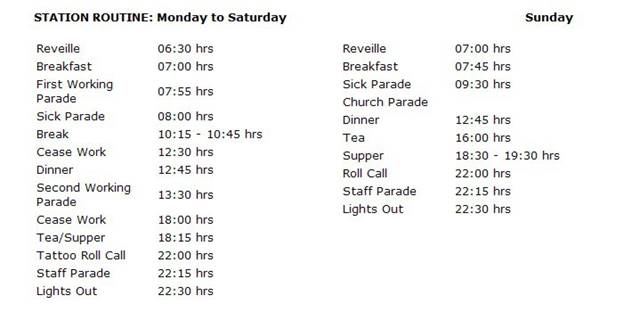
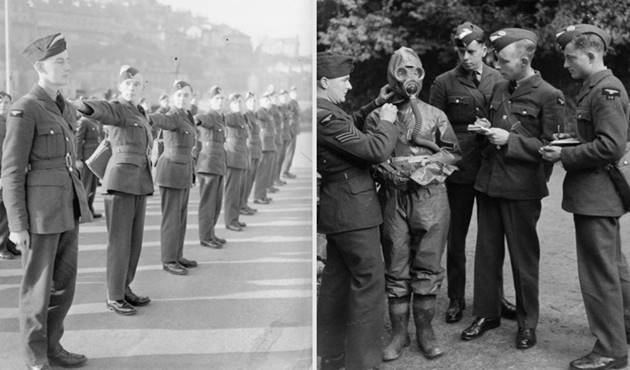
Drill and Anti-Gas Training [Photographs © IWM CH1793 / CH1801]
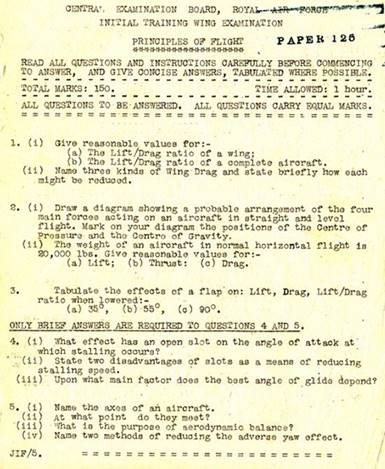
Example of a final paper.
Anyone who “failed” the course was either provided with additional training or was posted to other roles (eg: ground staff).
The next stop for Bert was RAF Locking, near Weston Super Mare, to train as a Flight Mechanic (Engines). The initial training was in the use of hand tools - files, hand drills, micrometers, verniers, etc. Various exercises were carried out to increase the student’s hand skills, including stripping down a radial aircraft engine, rebuilding it and test running it. The final examination consisted 'of written papers and an oral examination in identifying various engine parts. Most students passed out as Aircraftsman 2nd Class (A/C2).
After Bert successfully “passed out” from the course he was posted to No. 4 School of Technical Training (4 S of TT) at RAF St Athan in South Wales to start his “trade” training as a flight engineer. Here he would have been issued a White Flash to wear in his side cap indicating he was training for Aircrew. This was approximately a 24 week “trade” course.
The school had been set up by the Air Ministry in 1942 to provide specialist training for the flight engineers needed for four-engined heavy bombers and flying boats.
RAF St Athan
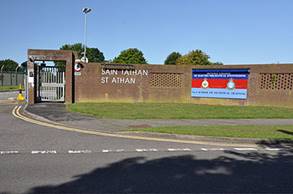
RAF St. Athan Today
RAF St.Athan, at this time, was one of the largest stations in the Royal Air Force. It consisted of two camps, known as East and West Camp, divided by the airfield. Training was generally carried out in the East Camp, with West Camp mainly used for general maintenance as a Maintenance Unit (MU).
The camp included:
- 20 Bellman hangars and 4 brick-built workshops (used as training facilities)
- a large equipment store
- a large amenities building with swimming pool, gym, cinema and chapels
- living quarters (for up to 4,000 instructors and trainees)
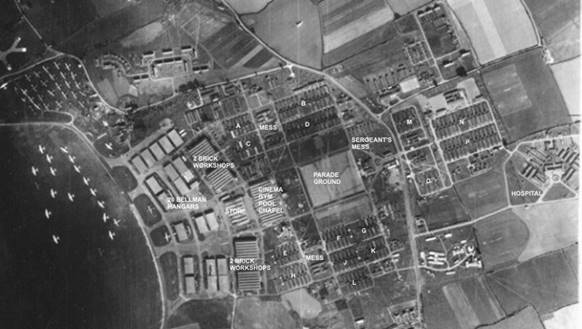
Annotated aerial view of East Camp at RAF St Athan (1945)
Based on an original Crown Copyright photograph: Royal Commission on the Ancient and Historical Monuments of Wales
The standard “bed space” was in one of the hundreds of wooden accommodation huts which were laid out in lines. Each hut accommodated up to 16 trainees and included latrines and showers, along with a small room for the billet’s NCO.
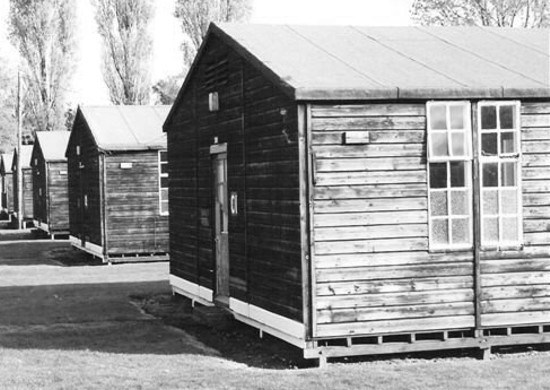
Airman’s Billets – RAF St Athan 1944
Training and Assessment
The aim of the technical course was to ensure that flight engineers could carry out their specified duties on the ground and in the air.
The preliminary phase of the course was:
- Preliminary Airframes (1 week)
- Preliminary Engines (2 weeks )
- Carburettors and Magnetos (2 weeks)
- Electrics and Instruments (1 week)
- Radial Engines / In-Line Engines (2 weeks)
- Hydraulics (1 week)
- Propellers (1 week)
(Some of these would have probably been skipped for Bert, following his RAF Locking training)
After a week’s leave, trainees continued with the intermediate phase of the course which incorporated:
- Merlin Engines (2 weeks)
- Typical Airframes (1 week)
- Typical Hydraulics (1 week)
- Propellers / Instruments / Electrics (1 week)
- Aerodrome Procedures (2 weeks)
The following are some original notes and diagrams from a former trainee:
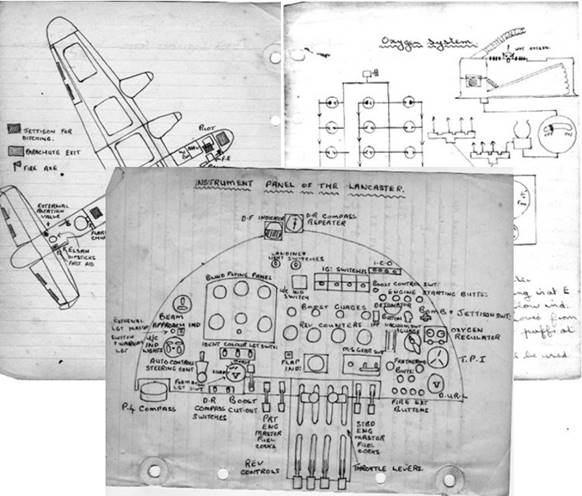
Training Notes [Courtesy of the late Clifford Leach]
After a further weeks leave, the trainees progressed to the final phase of the course which provided specific training on the aircraft and engines that they would be assigned to as they progressed into operational squadrons.
This phase consisted of:
- Airframes (2 weeks)
- Electrics / Instruments (1 week)
- Fuel Logs / Fuel Systems (1 week)
- Engines (1 week)
- Engine Handling (1 week)
Salvaged cockpits were used to provide a simulated flight environment to enable trainees to practice pre-flight checks, take-off procedures, “flying for economy” and landing procedures. In addition, a tethered airframe enabled the trainees to run engines up to full throttle, although the constant noise caused severe problems and St Athan became one of the early pioneers of “flight simulators”.
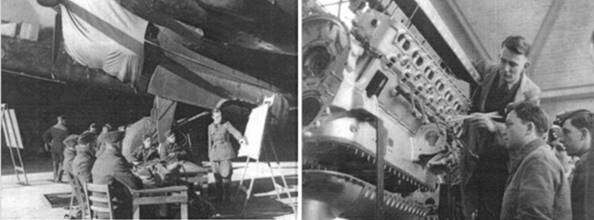
Flight Engineer Training [Photographs © IWM CH12466 / CH12467]
As part of this section of the course, Bert would have been required to spend a week at an aircraft manufacturers (“Makers Course”) to gain a better understanding of how the aircraft was constructed. In his case, that was probably a ‘Halifax’ Bomber course at “Rootes Securities Ltd”, probably at their “Shadow Factory” at Speke Airport, where they manufactured the Handley Page Halifax.
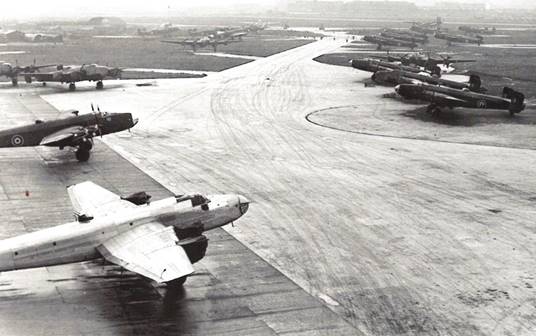
Halifax bombers await delivery (or in case of the front aicraft: the paintshop) at Rootes “Shadow Factory” at Speke Aerodrome/RAF Speke during World War II (Handley Page Association Collection, via Aircraft Q Failed To Return)
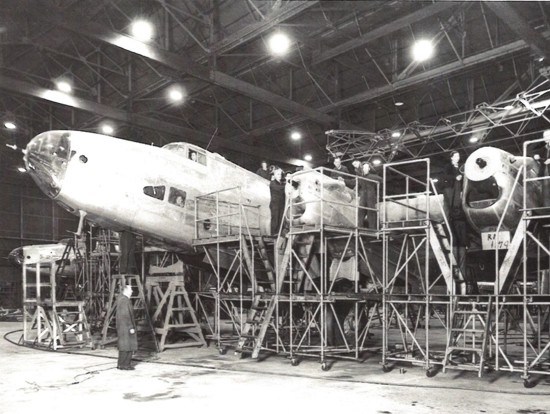
[Photograph courtesy of the Handley Page Association Collection]
Bert would have continued in the rank of AC2 (Grade A), Aircrafthand / U/T Flight Engineer until he was reclassified to AC2 (Grade B), Aircrafthand / U/T Flight Engineer. It is believed that this promotion came upon completion of the first part of the training course and that his pay would have been increased to 5/- a day (plus 6d a day war pay).
Following a successful six month course, Bert was awarded the Flight Engineer's brevet and the rank of Sergeant. Albert passed out from RAF St Athan on the 6th September 1944.
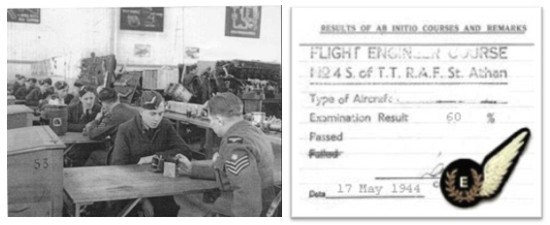
At his passing out parade in 1944, he received his coveted flight engineer brevet and was promoted to Sergeant, the minimum rank for aircrew, with a salary of 10/- a day (plus 6d per day war pay).
He was posted from St.Athan, now in the rank of Sergeant, to 1669 HCU (Heavy Conversion Unit) at RAF Langar. In October 1944, RAF Bomber Command had returned to Langar, moving in as No. 1669 Heavy Conversion Unit with 32 Lancasters which used the station until March 1945. Here he would begin his flying on the 17th October 1944 and become a member of a crew of seven. Pilot, Navigator, Bomb Aimer, Flight Engineer, Wireless operator, Mid Upper Gunner and Rear Gunner.
Sgt Len Brittain’s Wireless Operator Training.
The crew’s Wireless Operator was Leonard Brittain. His training would have been roughly as follows:
Basic Wireless Operator training
Training for a Wireless Operator was a thorough and exhaustive process, where instructors gave practical demonstrations on W/T aids to navigation and passed on their knowledge and expertise. The aim of the course was to produce a well-rounded, embryonic crew member who would quickly fit into a crew. Len did his training at RAF Yatesbury, East Camp. One of the Instructors there was Arthur C Clarke, later a famous Sci-Fi writer and inventor.
Gunnery training
After completing his Wireless Operator training, Len would have been sent on an ‘Emergency’ Air Gunner’s’ course, so it was off to an EAGS (Elementary Air Gunner School) to give him the basic training needed to take an Air Gunner’s position in times of need.
The course was much shorter than an air gunner’s course and there was no flying. He was instructed on the 303 Browning machine gun which included stripping and re-assembling, gun turrets, turret manipulation, sighting, aircraft recognition, types of ammunition, pyrotechnics, fuses and dinghies. Part of the course was firing from a gun turret on a range for one day. Mounted on a trailer was a Frazer Nash power operated four gun turret. A stationary engine on the trailer drove the hydraulic pump to operate the turret. On the range was an area with an electrified rail, the same as a greyhound track. Attached to the little trolley that circled the rail was a pole on top of which was mounted a model of a German aircraft.
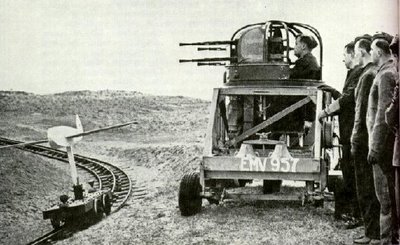
Early Air Gunner Training
But his training was not yet over, as a posting to a Signals Air Operating Course would have followed. Here, personnel spent 3 weeks flying in Anson aircraft carrying out Air to Air and Air to Ground wireless operations before becoming a fully qualified Wireless Operator, entitled to wear the ‘S’ half wing.
Five personnel would already have formed a crew and would have completed flying training on twin engine bombers, normally the Wellington.
This meant that they would need to add two members to their crew, Bert as their Engineer and a new Gunner, for the Mid upper position.
Their crew training was initially on the Halifax aircraft operated by 1669 HCU, but then they were posted to No 3 LFS (Lancaster Finishing School) at RAF Feltwell in November 1944, where they converted to the Avro Lancaster bomber, staying there until late November 1944. Their next posting as a crew was to 149 (East India) Squadron at RAF Methwold, making their first squadron flight on the 14th December 1944. During their introduction to 149 Sqn they did manage to clock up four Ops, being Siegen, Trier, Hangelar and Rheydi. All were carried out successfully.
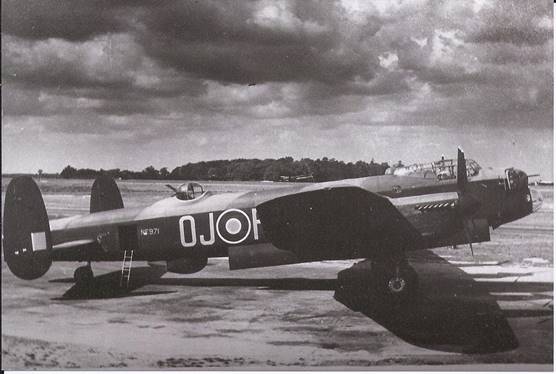
OJ-P serial number NF971, the ‘Count’.
At Methwold on an overcast day.
The crew arrived from No 3 Lancaster Finishing School, RAF Feltwell, with Flt Lt Versey as the Pilot and Skipper.
The full crew were:
Flt Lt B G Versey Pilot
Sgt L W Cass Nav
F.O. A Clarke Air Bomber
Sgt A R Miller Flt Eng
Sgt L Brittain W.Op
Sgt D Jackson MU Gunner
Sgt J A G Cox Rear Gunner
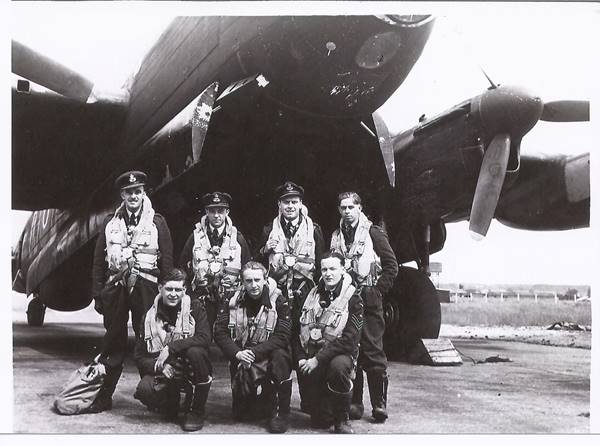
The full “Versey” crew 149 Sqn Operational history follows:
1st Op - Lancaster 1, serial MM708 coded OJ-Q
15th Dec ’44 Target – Seigen
Take Off (T/O) at 11.34 from RAF Methwold, landing at 14.29. It was not an auspicious start, as the crew were recalled along with the rest of the squadron. It is interesting that during the return trip the squadron jettisoned their bombs in a ‘safe’ area over the sea. For many years squadron members were certain that during this ‘load jettison’ the explosions were responsible for the loss of the ‘Norseman’ aircraft carrying Glenn Miller to France.
2nd Op - Lancaster 1, serial MF970 coded OJ-O
16th Dec ’44 Target – Seigen
Take Off (T/O) at 11.51 from RAF Methwold, landing at 17.06. Bomb load 1x400lb, 14x500lb and 4lb incendiaries. 10/10ths cloud. Bombed on G-H leader.
3rd Op - Lancaster 1, serial NG224 coded OJ-J
19th Dec ’44 Target – Trier
Take Off (T/O) at 13.03 from RAF Methwold, landing at 18.15.
Aborted over target due to leader’s G-H failure. Bombs jettisoned.
4th Op - Lancaster 1, serial NF362 coded OJ-S
24th Dec ’44 Target – Bonn Hangelar
Take Off (T/O) at 14.56 from RAF Methwold, landing at 20.36. Reported as: Clear. Bombed on T.I.s. 2 concentrations of TIs. There were more bomb bursts and fires on the S/W concentration.
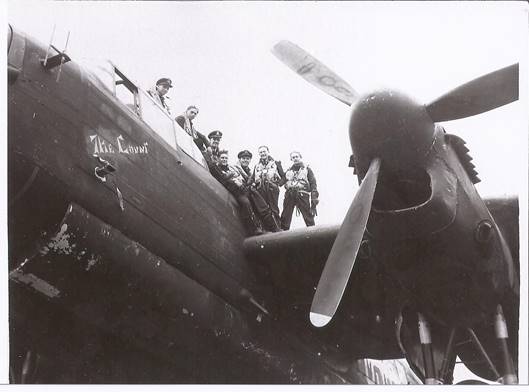
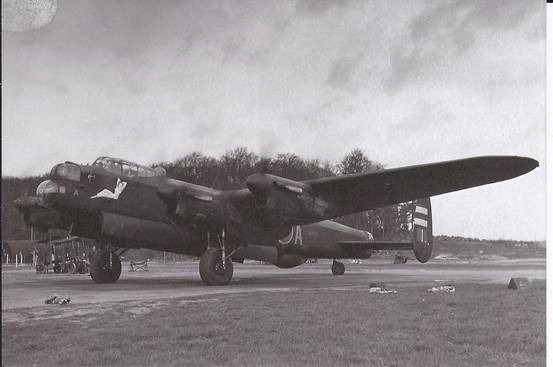
OJ-A clearly showing the G-H stripes on its rudder identifying it as a G-H equipped aircraft.
5th Op - Lancaster 1, serial NF362 coded OJ-S
27th Dec ’44 Target – Rheydt
Take Off (T/O) at 12.23 from RAF Methwold, landing at 16.51.
Bombed visually on yellow TIs (master bomber’s instructions). Explosions, smoke and fire. Concentrated attack.
6th Op - Lancaster III, serial LM692 coded OJ-P
2nd Jan ’45 Target – Nuremburg
Take Off (T/O) at 15.31 from RAF Methwold, landing at 23.06.
Weather – No cloud. A number of fires were seen and a great deal of smoke.
7th Op - Lancaster I, serial NE352 coded OJ-T
5th Jan ’45 Target – Ludwigshafen
Take Off (T/O) at 11.48 from RAF Methwold, landing at 17.29.
Clear, Good Visibility. No flares were seen.
8th Op - Lancaster I, serial HK551 coded OJ-J
7th Jan ’45 Target – Munchen
Take Off (T/O) at 18.47 from RAF Methwold, landing at 03.20.
Cloudy, Target area like daylight and many aircraft seen.
9th Op - Lancaster I, serial NM760 coded OJ-W
11th Jan ’45 Target – Krefeld
Take Off (T/O) at 11.54 from RAF Methwold, landing at 17.02.
Thin cloud, This aircraft was leading in the formation and at the time of bombing only one flare was seen.
10th Op - Lancaster I, serial ME252 coded OJ-T
13th Jan ’45 Target – Saarbrucken
Take Off (T/O) at 11.41 from RAF Methwold, landing at 17.59 (RAF St Mawgan)
No cloud over target, but haze and cloud all around. Some overshoots, but most of the bombs were falling in the target area as this aircraft passed over the target area.
11th Op - Lancaster I, serial ME252 coded OJ-T
15th Jan ’45 Target – Langendreer (Bochum)
Take Off (T/O) at 11.45 from RAF Methwold, landing at 16.46
Cloudy over the target.
12th Op - Lancaster I, serial NN756 coded OJ-R
22nd Jan ’45 Target – Duisberg/Hamborn
Take Off (T/O) at 17.12 from RAF Methwold, landing at 21.54
No cloud – good visibility. Bombing appeared to be very concentrated.
13th Op - Lancaster I, serial NM760 coded OJ-W
1st Feb ’45 Target – Munchen Gladbach
Take Off (T/O) at 13.20 from RAF Methwold, landing at 18.18
Cloudy – two blue Puffs visible near aircraft when the bombs were dropped. (Blue Puffs were the 250lb Flares carried for sky marking)
14th Op - Lancaster I, serial NG356 coded OJ-V
2nd Feb ’45 Target – Weisbaden
Take Off (T/O) at 20.40 from RAF Methwold, landing at 02.44
Cloudy.
15th Op - Lancaster I, serial NG356 coded OJ-V
3rd Feb ’45 Target – Dortmund/Hansa
Take Off (T/O) at 16.11 from RAF Methwold, landing at 21.37
No cloud – small fires were seen burning in the target area. Red TIs were well grouped.
16th Op - Lancaster I, serial NG356 coded OJ-V
7th Feb ’45 Target – Wanne Eickel
Take Off (T/O) at 11.47 from RAF Methwold, landing at 17.49
Very cloudy. Ground visibility – nil.
17th Op - Lancaster I, serial NG356 coded OJ-V
9th Feb ’45 Target – Hohenbudberg (Krefeld)
Take Off (T/O) at 03.32 from RAF Methwold, landing at 08.16
Thin cloud. TIs were down and well grouped.
18th Op - Lancaster I, serial NG356 coded OJ-V
13th Feb ’45 Target – Dresden
Take Off (T/O) at 21.54 from RAF Methwold, landing at 06.55
Hazy, but no cloud below. Whole area was alight and visible from 150 miles away.
19th Op - Lancaster I, serial NG356 coded OJ-V
14th Feb ’45 Target – Chemnitz
Take Off (T/O) at 20.09 from RAF Methwold, landing at 04.40
Cloudy. No sky markers were seen.
20th Op - Lancaster I, serial NF972 coded OJ-S
20th Feb ’45 Target – Dortmund
Take Off (T/O) at 21.40 from RAF Methwold, landing at 03.34
Thin cloud. Flares seemed rather scattered.
21st Op - Lancaster I, serial HK654 coded OJ-G
23rd Feb ’45 Target – Gelsenkirchen
Take Off (T/O) at 12.00 from RAF Methwold, landing at 18.15 (RAF ACklington)
Cloudy. Nothing seen over target due to cloud.
22nd Op - Lancaster I, serial HK654 coded OJ-G
27th Feb ’45 Target – Gelsenkirchen
Take Off (T/O) at 11.14 from RAF Methwold, landing at 16.43
Cloudy. Cloud covered the target area, Blue Puffs were well concentrated.
23rd Op - Lancaster I, serial ME352 coded OJ-T
2nd Mar ’45 Target – Koln
Take Off (T/O) at 12.45 from RAF Methwold, landing at 18.27
Abortive sortie. All bombs brought back to base.
24th Op - Lancaster I, serial PB509 coded OJ-C
23rd Mar ’45 Target – Wesel
Take Off (T/O) at 13.51 from RAF Methwold, landing at 03.45
Slight haze only. A lot of smoke and a very large explosion seen.
This was marked in the logbook as a ‘special target’. 10 picked crews - target 1500 yards ahead of Field Marshall Montgomery’s troops. Successful.
25th Op - Lancaster III, serial PA186 coded OJ-A
5th Apr ’45 Target – Merseburg
Take Off (T/O) from RAF Methwold, landing after 9.00 hrs
Low cloud. TIs very scattered. Large areas of fire seen.
26th Op - Lancaster I, serial NF971 coded OJ-P
18th Apr ’45 Target – Heligoland
Take Off (T/O) at 09.37 from RAF Methwold, landing at 15.02
No cloud – good visibility. A great deal of smoke seen and only the northern end of the island visible. This was the crew’s last War Operation.
Non-Operational Flights – the rest of the crew’s time on 149 Squadron.
During May 1945 the crew flew five sorties consisting of a trip to the Hague on supply dropping (Operation Manna) a series of trips to and from Juvincourt carrying up to 24 POWs being repatriated to the UK and a ‘Baedeker’ trip which visited Courtral, Aachen, Duren, Cologne, Coblenz, Weisbaden, Frankfurt, Kassel, the Mohne Dam, Dortmund, Duisberg and Wessel.
The Baedeker trips carried ground staff to show them the results of their contribution to the war effort by showing them some of the bombed cities and other targets. Quite a few of them were badly affected by these trips and they were discontinued quite quickly.
In October 1945 the crew left 149 Sqn for RAF Tuddenham and No 138 Squadron, again with Lancasters.
The crew flew missions from Tuddenham between November 1945 and April 1946.
For them, the War was finally over. Indeed, an illustrious career for the crew.
History records that for over fifty five and a half thousand British and Commonwealth aircrew, their lives were over.
They went with songs to the battle, they were young.
Straight of limb, true of eyes, steady and aglow.
They were staunch to the end against odds uncounted,
They fell with their faces to the foe.
They shall grow not old, as we that are left grow old:
Age shall not weary them, nor the years condemn.
At the going down of the sun and in the morning,
We will remember them.
This site is © Alan Fraser, or as
assigned, All Rights Reserved.
|
 Stirling Pilott
Stirling Pilott 
 Stirling Pilott
Stirling Pilott 